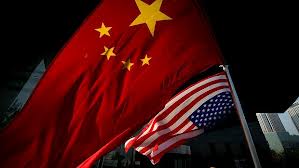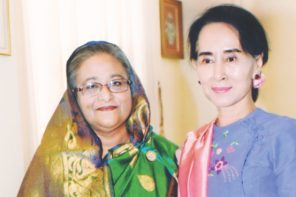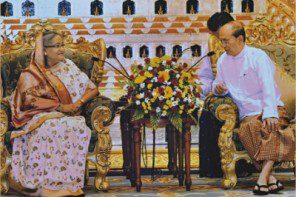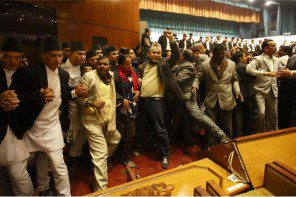THE NEW GAME IN ASIA AND PERSPECTIVES ON BANGLADESH’S FOREIGN RELATIONS
 In determining the course of Bangladesh’s foreign relations – the words of a famous Prussian /German statesman of the nineteenth century and renowned figure in world affairs Otto von Bismarck may be apt -“if you have five neighbors, you need to be on good terms with at least three”. China and India are the two powerful nations in the region that are experiencing economic expansion of unforeseen magnitude. Both China and India are easing the tensions with their neighbors by putting to rest ‘old antagonisms’ for ensuring success in the pursuit of their policy for economic expansion.
In determining the course of Bangladesh’s foreign relations – the words of a famous Prussian /German statesman of the nineteenth century and renowned figure in world affairs Otto von Bismarck may be apt -“if you have five neighbors, you need to be on good terms with at least three”. China and India are the two powerful nations in the region that are experiencing economic expansion of unforeseen magnitude. Both China and India are easing the tensions with their neighbors by putting to rest ‘old antagonisms’ for ensuring success in the pursuit of their policy for economic expansion.
Is Bangladesh ready for the new game in Asia? This new game centers on an evolving balancing act of the United States as the dominant superpower vis-à-vis the regional rivals, namely, India and China, and the smaller powers of the Asia-Pacific region. In the past, the mentor-protégé relationship was driven by the desire of the stronger state to dominate the weaker or less powerful state. This relationship was asymmetric in favor of the stronger state characterized by a top-down diktat. Russia’s relations with the Eastern Bloc nations provide a good example of asymmetric relationships. However, the recently evolving relationship between the US and the nations of the Asia-Pacific denote a bi-directional interaction based on the interests of both the superpower and the less powerful and smaller statesin the region. Unlike previous mentor-protégé relationships, the US pivot to the nations in the Asia-Pacific is not only driven by the desire of the dominant power but also by the smaller states initiating a partnership for protection of mutual interest. Therefore, it may be inferred that this ‘two-way’ relationship will be more enduring since it serves the interest of both parties. US pivot toward the Asia-Pacific has been highlighted by the visit of President Obama to Thailand, Myanmar and Cambodia recently. Thailand is a staunch ally of the US and a free market economy. Therefore, the Thai Prime Minister Yingluck Shinawatra warmly welcomed the US President perhaps based on a mutual understanding of the gains to be made from further expansion of the superpower into the region. Myanmar is beginning to show signs of cooperation with the outside world and beginning to come out of isolation resulting from more than 50 years of military rule. Myanmar’s relationship with the West and particularly the United States may serve some of its economic objectives. Foreign direct investments and the lifting of sanctions will provide a big impetus to Myanmar’s economic growth. US objectives to gain as many adherents to its network of allies by forming partnerships with nations in the Indian and Pacific Ocean through the Strategic and Economic Dialogue (S&ED) serves various national security interest(s). Protection of the strategic oil routes through the Malacca Straits, access to the vast energy resources of the South China Sea, and countering the Chinese ambition in the Indian and the Pacific Ocean is vital to preserving American strategic objectives in the region. Therefore, the political-military stratagem of the superpower is to win over the littoral nations of the Indian and Pacific Ocean. The Philippines, Vietnam, Thailand, Myanmar, India and Bangladesh offer significant advantages to the US Navy by allowing port visits and use of certain facilities in the region. The underlying cause of the conflict between China and Vietnam lies deep in the coastal waters of South China Sea that holds an estimated reserve of 17 billion tons of oil and about 498 trillion cubic feet of natural gas. The Philippines reopened the Subic Bay and Clark air base for use by the US naval and armed forces. These forward bases provided logistical-strategic advantages to the US Armed forces during the Vietnam War. Subic Bay base can be used by submarines and large naval fleets belonging to the US Navy.
Recent interactions between the superpower and the Asia-Pacific nations suggest that the smaller states like Vietnam and the Philippines may be reaching out to the powerful state for protection against the challenging stance of the regional hegemon over their rightful claims to the offshore oil and gas resources.
Secretary Clinton’s visit to Dhaka during May 2012 marked the beginning of a new era in Bangladesh-US relations. Secretary Hillary was warmly greeted by the leaders of the ruling party as well as the opposition and intelligentsia amidst the prevailing mood marked by heightened optimism mixed with a bit of subdued skepticism. However, recent visits of high powered State Department officials to Dhaka provoked many questions and doubts on the purpose and expectations thereof of the superpower. Therefore, relations between the two countries needs to be re-evaluated in light of US bilateral as well as global and regional – political, economic and strategic interests.
A card game may be used to illustrate the questions and issues related to the expected role(s) and behavior of the client-state (‘Bangladesh’) on a regional level. Supposing, the client-state is holding three cards – an ace of spades, a king of clubs and queen of hearts. China is the country’s Ace card since it enables the client-state to counter the dominance of India and maintain an independent political stance in regional and international affairs. India is the Queen of Hearts who rescued the client-state in 1971 during the war of liberation and freed the people from Pakistan. America, the King of Clubs, with a defined objective to play a decisive role in the Asia-Pacific region, and a superpower seeking to form economic and security partnerships with potential client-states.
Bangladesh’s relation with India is the most intense due to the common culture, history and tradition. India poured out its heart during 1971. Prime Minister Indira Gandhi rightfully occupies a place in the hearts and minds of the people of Bangladesh. Demise of Bangabandhu from the scene somewhat depressed the positive feelings prevailing between the two nations and a rift began to appear in the relationship between the more powerful and dominant South Asian power (India) and the newly independent nation (Bangladesh). Bangladesh was poised to avoid any sense of Finlandization, and the ensuing relationship wavered between friendship and animosity throughout the eighties and nineties. An anti-Indian sentiment seemed to pervade throughout the nation, albeit indiscreetly amongst the political and business elites as well as the general masses.
An assertive political leadership by Major-General Ziaur Rahman sought to diversify the foreign relations of the newly independent nation. During the early eighties Bangladesh began to develop economic and political ties with the far away land of the Arabs in the Middle East, and leaned further towards the Islamic world. Furthermore, during this period Bangladesh government also revived the relations with the erstwhile archenemy Pakistan. Belated recognition of the newly independent nation by China in 1975 changed the scenario facing Bangladesh. This turn of events marked the beginning of friendship between the two nations that may be described as functional in the economic sense but counterpoised against India, politically. Bangladesh used China as a trump card (Ace) to forestall any intent of Indian domination.
Sino-Indian tussle over Bangladesh may be traced back to the diversification of the foreign policy of the Zia regime. Private enterprise began to take-off in Bangladesh during the 1980s leading to increased cooperation between Bangladesh and China. Many Bangladeshi businessmen complained about being dumped on by inferior Indian goods and began to appreciate the low cost competitive products from China; and trade between the two countries improved significantly from the eighties onwards. Anti-Indian sentiment seemed to pervade throughout the population and the various interest groups began to take a stand against India – primarily fueled by the inequitable sharing of the Ganges waters. Bangladesh’s foreign relations with the big brother fluctuated between friendship and animosity but for the most part remained ‘cautious’ during the BNP rule, and ‘favorable’ under the Awami League government.
Recent discussions between the representatives of the United States and Bangladesh government indicate a new initiative in the bilateral relations. Previously, the United States appeared as a donor country by giving aid and succor to Bangladesh, especially during famine, floods and for the post-war reconstruction and rehabilitation. However, the withholding of the TICFA (Trade and Investment Framework Agreement) with the United States by the Government of Bangladesh on labor rights issues, and the delay in according more preferential treatment to the apparel-garment exports by the US caused some strains to appear in the bilateral relations.
US role has been significant for Bangladesh since the reconstruction of the war-ravaged economy would have been difficult without the assistance from the US Agency for International Development (USAID). During the early to mid-seventies the United States provided much of the economic assistance in the form of food aid under PL-480 program. The eighties witnessed the new born country beginning to climb out of depression.
During the eighties and nineties US policy towards Bangladesh was predominantly concentrated upon promoting democracy and economic development under the guise of various USAID programs. United States foreign policy establishments always seemed to put Bangladesh on the back burners despite significant progress on the promotion of democracy, human rights and development. This may be largely attributed to the general neglect of the S. Asia region by the State Department; and, could be interpreted as a regional bias than a particular stance on any policy towards Bangladesh. Regional implications – especially, the emergence of India and China as rapidly growing economies influenced policy makers in the State Department to elevate S. Asia’s status.
Around the turn of the century with the attack on the World Trade Center, United States foreign policy embarked on a new course. This new direction of US policy sought to track down and destroy terrorism, and therefore, focused on the muslim majority states of the Middle East and South Asia region. US policy towards Bangladesh received increased attention from the policy makers in Washington, DC due to the security interest. Bangladesh governments’ willingness to cooperate with the US in wiping out terrorist elements from the country gave a new impetus to the bilateral relations. Bangladesh’s cooperation on security and terrorism issues was noted by several of the visiting diplomats from DC desiring to broaden the relationship with this moderate muslim nation to include, as well, economic and security dialogue.
Secretary Clinton embarked on a tour of Asia to enlist countries to join the security and economic dialogue (SE&D) for Asia-Pacific countries. Cooperation of Bangladesh as well as the littoral states of the Pacific and the Indian Ocean appeared to be crucial for the success of the strategy, described by President Obama as America’s Pacific Century.
However, Bangladesh may have to be wary about a backlash from China if the relationship with the United States accelerates at a faster pace than normal. Conceivably, joint naval exercises between Bangladesh and US navy may warrant a reaction from China if it is perceived as a threat by the latter. If the security-strategic cooperation with the United States navy assumes a higher level of partnership than what is acceptable by China then it may jeopardize Bangladesh-Chinese cooperation on trade, economy, and investments. China has significant economic interest in Bangladesh as its largest trading partner and with involvement in the energy and infrastructure sectors as well as in manufacturing, mining and trading. On another note, there is sufficient reason to believe that Chinese assistance for the deep-seaport in the Bay of Bengal may be sacrificed in case Bangladesh accedes to any form of security and strategic partnership with the United States. Bangladesh needs to be cognizant of the underlying Sino-US conflict since both these external powers are trying to extend their influence by colluding with their allies in the region. In this game, Bangladesh may have to consider the reaction of the Chinese before making any commitment to the Americans – allowing access to the US naval ships to the Chittagong port may make it off-limits to the Chinese and vice versa. Chinese backlash may or may not be directly inflicted but indirectly applied or instigated through Myanmar or Maoist infiltration along the Bangladesh-Indian borders. Similarly, the Bangladesh government has been extremely cooperative to the US request for implementation of the anti-terrorism policy but has not given due cognizance to the Indian indirect request for allowing access to counter the insurgencies in the NE Indian states bordering Bangladesh. Bangladesh therefore may be better off by cooperating with the neighboring countries of India and Myanmar and by adroitly balancing the Chinese and the United States that are seeking to extend their sphere of influence.
The author is a consultant. He specializes in US Foreign Policy and International Trade & Business
First published in FAIR magazine, Issue4.





